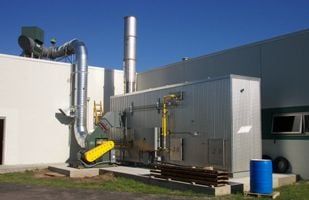Today many companies are faced with unique air pollution control problems arising from their part coating operations. Not only are vented emissions required to be controlled, but now a more pressing issue is how to treat fugitive emissions.
Fugitive emissions are the VOC and HAP releases that occur at the coating process or in a mixing area. Fugitive emissions are sometimes difficult to capture when the process has auxiliary equipment considerations, human inspection requirements, or frequent cleaning procedures to follow.
In many instances current EPA regulations will call for an overall Control System Efficiency (CSE) of at least 95% or greater depending on circumstances. In some instances this is also referred to as Capture and Control. The control aspect can be relatively straight forward, this refers to the air pollution control device (Catalytic, Thermal, or Regenerative Thermal Oxidizer’s) If designed incorrectly, the capture aspect can cost the additional operating expense, risk health and safety of their employees, and limit the overall CSE.
One very effective method of meeting 100% capture is to engineer a Permanent Total Enclosure (PTE). A expertly designed PTE will address these five criteria under Method 204:
- Any natural draft opening (NDO) shall be at least 4 equivalent opening diameters from each VOC emitting source. An equivalent diameter is equal to the diameter of a circle that has the same area as the opening.
- The total area of combined NDO's shall not exceed 5% of the total surface area of the enclosure including the floor and ceiling.
- The average face velocity (FV) of air through the NDO's shall be at least 200 ft/min and the direction of flow shall be into the enclosure.
- All access doors and windows not included as NDO's shall be closed during routine operation of the process.
- All exhaust gases from the enclosure must be directed to a control device.
Most State and local regulatory agencies have adopted these criteria as a basis for PTE design.
A verified PTE will be granted 100% capture. When these emissions are directed to the appropriate control device, the overall CSE is easy to measure and test by performing the required testing methods at the air pollution control device. There are other forms of capturing fugitive emissions such as localized hooding or pick-up points, but these methods require exhaustive and expensive testing that may not yield the required results.
Recently Catalytic Products International (CPI) was called on by a large Tier One Automotive supplier to solve their air pollution emission problems in their fastener coating operations. The challenge came in designing a control system that addresses fugitive emissions from many oddly designed coating/curing systems. After extensive review of the application and the options to consider it was decided to enclose all of the coating systems within a PTE. The PTE needed to address fork truck traffic, human traffic, materials handling, hygiene issues relating to room air quality, among others…
Then selecting the appropriate air pollution control device was looked at. Since Catalytic Products International is one of the only equipment designers that makes all three types of thermal treatment systems, there were a few choices to consider.
- Thermal (recuperative) Oxidation was not considered as the operating costs were too high.
- A Rotor Concentrator System (RCS) was not considered as the high capital costs could not provide adequate ROI
- A Regenerative Thermal Oxidizerwas narrowly beat out as the choice because it could not compete with the lower operating costs offered in the VECTOR Catalytic Oxidizer.
CPI recommended installation of a Catalytic Oxidizer with a 75% efficiently primary heat exchanger, a unique raw gas burner system, and CPI’s PRO Catalyst with Split-Bed Tray System. The VECTOR Series Catalytic Oxidizer is an industry leading control system that optimizes energy consumption by offering the lowest natural gas use (even in low solvent applications), low electrical demand, burner technology that does not relay on a combustion air source, and PRO Catalyst that offers low temperature conversion of most VOC’s.
In many instances, the VECTOR-Series Catalytic Oxidizer will consume less natural gas and electricity than similar sized RTO systems. An added benefit is that the Catalytic Oxidizer can easily accept higher solvent loadings without costly additional equipment. The VECTOR-Series Catalytic Oxidizer has other unique features such as:
- Split Bed Tray Catalyst – Maximizes the catalyst investment and offers options to add a sacrificial guard bed to protect the catalyst from contaminates.
- No internal moving parts – Makes maintenance easier and less costly Lightweight & Compact – Ideal for rooftop installations or at sites where space is limited
- EPA compliant – works throughout wide ranges of air volumes and solvent loadings
- Secondary Heat Recovery – Options for integrating economical heat recovery solutions
Catalytic Products International is a worldwide leader in the design and manufacture of custom air pollution control systems. Other products include; Regenerative Thermal Oxidizer's, Thermal (recuperative) Oxidizer’s, Concentrator's, Particulate Control, Energy Conservation System's, and special services to meet a multitude of needs.
For more information about this system or any of the VOC abatement systems designed and manufactured by Catalytic Products International, please contact us.








